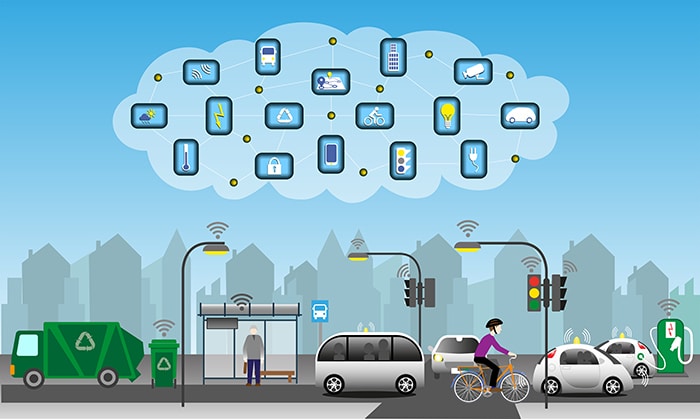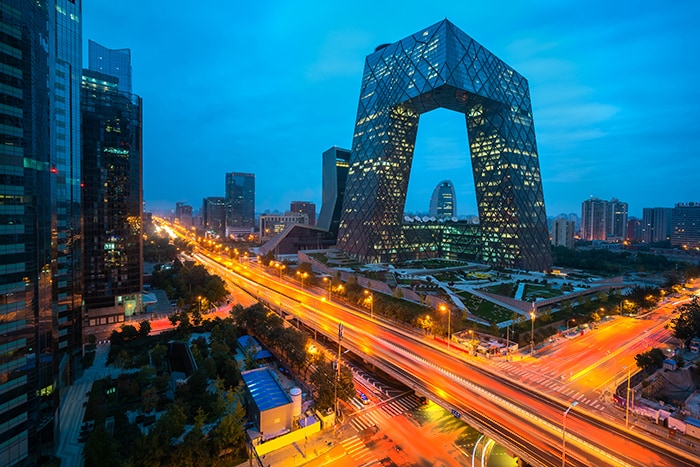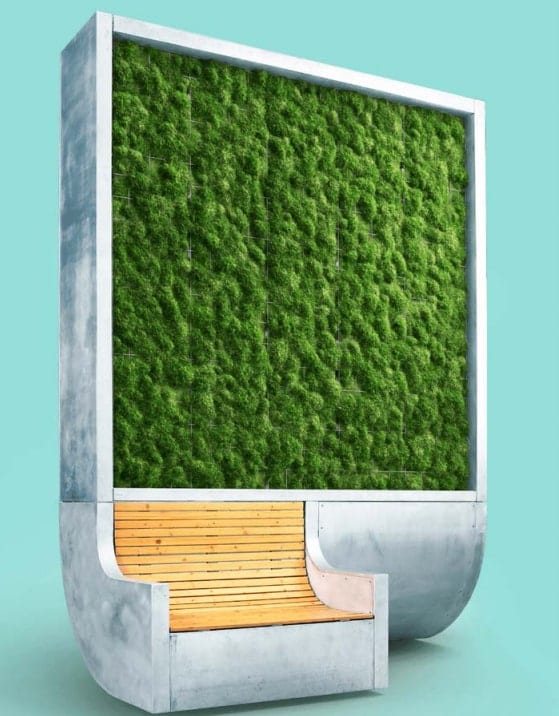
Cities are powerful magnets for people. According to the United Nations, nearly half of the planet’s population live in a conurbation of more than 500,000 people and this number is set to rise to over two-thirds by 2050. In addition, the number of megacities–those with populations exceeding 10 million–has increased from 10 in 1990 to 28 today and is forecast to increase to 41 by 2030.
This isn’t necessarily bad news. Well-managed metropolises encourage economic development and improve job prospects, housing, electricity, water, sanitation, transportation, healthcare, and education for their inhabitants. And providing services is much less expensive and more environmentally sustainable than doing so for a rural population.
But cities have problems that multiply as their size grows. One of the most intractable is traffic congestion. Congestion clogs city arteries and stalls economic process, but its impact on human health is even worse. Traffic continuously pumps noxious emissions, including 2.5µm diameter (and less) atmospheric particulate matter (PM) into the air. This PM2.5 pollution penetrates deep into the lungs and is deemed the most hazardous to health.
Conventional attempts to control traffic to limit pollution—such as congestion charging or preventing certain vehicles traveling on particular days—are cumbersome and fail to take account of factors such as weather and transient traffic conditions such as road works or accidents.
But now, widespread deployment of commercial air-quality sensors—wirelessly connected to the Internet of Things (IoT) via low power wireless area networks (LPWANs)—promises to generate the fine-grained data that city planners need to be more reactive to the build-up (and clearing) of atmospheric pollution. Some pioneering authorities are embracing the fledgling IoT to clean up their cities’ air, but much more needs to be done to implement pollution control systems that befit the smart cities of tomorrow.
Carmaggedon
Henry Ford’s U.S.-based production line is credited with introducing independent mobility to the masses and city planners were quick to embrace this cultural revolution. For example, 1920s Los Angeles’ design was pretty much dictated by the car. The city’s low population density and far-flung suburbs were created because of the ease with which people could move around using cars during a decade of rapid expansion from 1910. Today, LA’s traffic system has become a victim of its own success. In 2017, the city’s congestion was the world’s worst for the sixth year in a row, according to INRIX, a transportation analyst. The company says that LA’s commuters are destined to spend over 100 hours a year battling peak-hour congestion.
But congestion is not a uniquely American problem. In China and India, countries where a rapidly expanding middle-class is spending much of its disposable income on cars, the problem is bad and set to get much worse. In Mumbai, for example, with a metropolitan population of around 18.5 million inhabitants, and 2.3 million vehicles, a 55 percent increase in the past seven years, new vehicle registrations numbered around 700 a day in 2017. Beijing’s vehicle fleet is equally impressive, numbering 5.97 million for a metropolitan population of 21.7 million (Figure 1).

Sources of Particulate Pollution and Its Effects
PM2.5 pollution has many sources, including coal- and oil-fired power stations, domestic cooking, and even natural sources such as dust and sea salt. But a study in Gwangju, Korea, showed that over a third of the particulate matter in that city was attributable to diesel- and gasoline-powered vehicles.
It’s a similar story in Beijing. In late March 2017, the city’s PM2.5 concentration was 238µg/m3 and the city averaged 90µg/m3 over the year. World Health Organization (WHO) guidelines state that an average PM2.5 reading of just 25µg/m3 over a 24-hour period is unhealthy. The Chinese city’s inhabitants are paying a steep price for mobility. A 2016 report by Nanjing University’s School of the Environment concluded that 31.8 percent of all deaths in Beijing (and other congested cities in China) could be linked to PM2.5.
Although not as bad as Beijing, Mumbai, with its large car fleet and the bar set low for emission standards, the city often suffers from appalling air quality. The Times of India reported that the city is ranked the 63rd-most polluted among a list of 859 cities around the world and is the fourth-most polluted megacity. In 2016, the city’s mean PM2.5 level was 64µg/m3. Although Beijing and Mumbai are outliers, Western cities have no reason to be smug. LA records an average annual PM2.5 reading of 18µg/m3. In Europe, Paris recorded a peak reading of 55µg/m3 in February 2018.
According to the WHO, air pollution is mainly responsible for non-communicable diseases, causing around 24 percent of all adult deaths from heart disease, 25 percent from stroke, 43 percent from chronic obstructive pulmonary disease, and 29 percent from lung cancer.
Pollution Mitigation 1.0
Several city authorities have grappled with the task of cleaning up their residents’ air. Some attempts are more bizarre than others. According to the BBC, Delhi has toyed with the idea of mounting jet engines on flatbeds and towing them to heavily polluted areas to use the engines’ thrust to push particulates high into the atmosphere and away from lungs. Beijing also has recently introduced a permit-system limiting non-resident to just 12 drives into the city in one year.
More conventional attempts to control airborne particulates include the deployment of monitoring equipment for a few months over a national pollution hotspot to establish a pattern followed by harsh measures such as limiting access or ramping-up emission taxes to discourage traffic until the air becomes clearer. Such initiatives fail to take account of transient factors such as weather and auto-accidents, while the heavy-handed solutions frustrate drivers and generally produce short-term results.
Using Conventional Technology to Limit Particulate Pollution
By deploying contemporary electronics such as sensors and web cameras, some U.S. cities are achieving better results. Chicago, Ill., for example, uses lamp post-mounted sensors to build up a picture of the pollution over time in large areas of the city, while Pittsburgh, Pa.’s residents can use webcams to zoom-in on specific sources of emissions and make recordings of pollution events to identify a pattern. Elsewhere, Louisville, Ky., identifies pollution hotspots by gathering data about when asthma patients use inhalers.
Outside of the U.S., Oslo allows bus-lane access, provides lots of recharging stations and privileged parking, and eliminates tolls for electric vehicles. Norway has the highest per-capita number of all-electric cars in the world, more than 100,000 for a country of 5.2 million people. Oslo’s mean PM2.5 reading in 2016 was 11µg/m3. Dresden, Germany, is trying to filter particulates from the air by implementing pollution-absorbing “green walls” (Figure 2).

Connectivity Improves Pollution Control
Initiatives cutting the number of cars entering cities are bound to have some impact on air quality. Fewer tailpipes equal lower emissions. But the impact is often not as high as anticipated. London, for example, introduced a congestion charging scheme in 2003. By 2014, traffic volumes in the charging zone were nearly a quarter lower than a decade ago. But the number of buses has increased, and taxi and private hire vehicle journeys have risen by nearly 30 percent since 2000.
Has London’s congestion charge improved the air for the city’s population? In 2003, the city’s mean PM2.5 reading was 25µg/m3 (rising to 35µg/m3 in central areas), while in 2016, it was 15µg/m3 (rising to 18µg/m3 in central areas). That’s a marked improvement but still means air quality is well above the WHO threshold of 10µg/m3.
London’s experience demonstrates that tackling air pollution is governed by dozens of dependent factors and changing one can (sometimes detrimentally) affect others. To react quickly to pollution peaks and bring down the mean level over a period of time requires data … lots of timely and accurate data.
The Internet of Things’ (IoT) capacity to quickly generate, collate and analyze data from compact, inexpensive wireless sensors—connected to the Cloud via LPWANs—will enable city planners to take advantage of big data to improve air-pollution control.
Building an IoT Air Pollution Control System
An IoT based air-pollution system will comprise four essential elements:
- Wireless air quality sensors to monitor and report pollution levels;
- LPWAN connectivity to transmit data from short-range wireless sensor networks to the Cloud;
- Cloud servers with the power to analyze data from tens of thousands of wireless sensors;
- Predictive algorithms to suggest measures to prevent air pollution building to hazardous levels.
Compact, inexpensive, battery-powered PM2.5 sensors are becoming commercially available. The data from these devices can be supplemented by metal oxide semiconductor (MOS) gas sensors which can be tuned to pick up the nitrogen dioxide (NO2) and carbon monoxide (CO) prevalent in exhaust gases to give an overall indication of the air pollution created by vehicles. The sensors are commonly paired with an RF transceiver using a battery-friendly wireless protocol such as Bluetooth Low Energy (BLE) or Zigbee so that data can be continuously transmitted across a network. Because PM2.5 and gas sensors are cheap and unobtrusive, they can be widely distributed across a city to monitor air pollution.
LPWANs form robust, long-range, secure connections between the local area networks (LANs) of short-range wireless sensors and the Cloud. Several LPWAN technologies are currently being commercialized including cellular IoT technologies such as LTE-M and NB-IoT, LoRaWAN, Sigfox and Weightless (Figure 3).

Once the data is uploaded to the cloud via an LPWAN, it can be aggregated and analyzed to build an almost real-time, fine-grained picture of how air-pollution is changing throughout a city. As the historical database builds, algorithms can refer to past events to accurately predict how future patterns will play out—enabling authorities to take preventative measures if needed. Such information will allow more subtle actions than traditional measures, such as regulating traffic flows, temporarily lowering road tolls for cleaner vehicles and quickly advising citizens, via the cellular network or internet, to avoid areas that might soon become hazardous.
Early Adopters
London
London is building on its experience with congestion control by introducing an IoT-based trial in the Royal Borough of Greenwich in collaboration with GSMA, an alliance of cellular infrastructure providers. The project, dubbed Smart London uses a combination of sensors, cellular IoT LPWANs, and big data analytical techniques. The sensor network comprises low-cost static and mobile devices attached to vehicles, bikes, and people. The data is complemented by that from existing Greenwich air-quality monitoring stations.
The information is allowing the authorities to make early decisions. For example, data from the air-quality measurements is being used to inform subscribers to a service called AirTEXT, via smartphone notifications, when pollution levels are likely to rise in their area. As a result of the data analysis, the borough has introduced pollution mitigating measures such as introducing a ban on large delivery trucks and instead employing a contractor that delivers parcels by bicycle.
While it is early days for Greenwich’s experiment, levels of PM2.5 are showing a modest decline (Figure 4).

Seoul
The South Korean capital is home to an IoT-based air pollution monitoring scheme operated by a local telecoms operator. For a developed country, South Korea’s air is dirty. In late March 2018, Seoul’s PM2.5 peaked at 100µg/m3. The Air Map Korea project collects air-quality data via nationwide infrastructure, including 4.5 million telephone poles, 330,000 mobile base stations, 60,000 public phone booths, and 4,000 central offices in Korea. In addition to PM2.5 and PM10 levels, the sensors also track temperature, noise levels, and humidity. Sensor data is relayed via a cellular IoT LPWAN to the company’s existing 4G and new 5G mobile networks. Once collected, this information is transmitted to the company’s Air Map Platform every minute.
So far, Seoul’s air-quality initiative has produced limited results. The city government has taken steps to encourage people out of their cars—such as waiving public transport fees during rush hours, closing parking lots, and introducing fines and bans on certain diesel-fueled vehicles when pollution hits a peak—but the measures reduced traffic by only around two percent. PM2.5 improvements over the past five years were described as stagnant by a Korean government spokesperson, according to U.S. News & World Report.
Acting on Air Quality Data
What London and Seoul’s experience indicates is that measurement of pollution is one thing, acting on the information so that it has a meaningful impact is quite another. But it’s early days for the IoT and in the medium-term, city planners will benefit from the large amount of current and historical data that builds up as a result of widespread monitoring networks and Cloud storage.
Improving Response
How to react to data generated by the IoT is in large part governed by the political climate, but technology can play a larger role in the decision-making process by ensuring the public is informed with accurate information in a timely manner. That way, citizens are more likely to accept measures that make personal mobility more expensive or even restricted.
Introducing enhanced sensor technology
Advances in low-power wireless and semiconductor technology are making air-quality sensors cheaper, smaller, lower maintenance, more accurate, and longer range. As a result, future pollution-control schemes will be able to take advantage of much greater deployment of sensors and improved measurement precision.
Extending Sensor Mesh Networks
Widespread deployment is also aided by developments such as Bluetooth® mesh and Zigbee®’s inherent mesh compatibility. Networking allows sensors to communicate with each other, reducing the number of LPWAN nodes required because data can be aggregated to, and relayed from, a single point on a large network. Such an arrangement reduces cost and complexity.
Deploying City-Wide LPWANs
LPWANs play a key role in building the IoT. Cellular IoT offers an early advantage because 4G (and increasingly 5G) networks are already built-out in most cities – allowing early traction for suppliers of metropolitan cellular IoT services. LoRaWAN, Sigfox, and Weightless are busy building up infrastructure across major cities for support their technologies. Once in place, these LPWANs will provide a backbone for rapid and inexpensive deployment of wireless sensor networks in any area of a city.
Using Artificial Intelligence to Act Early
Building on huge data resources and employing the power of server farms, engineers will develop algorithms that intelligently consider the complex interplay of factors that affect air-pollution, produce accurate predictions and suggest early (and subtle) actions to mitigate hazardous levels. Examples include the air purifying plants South Korea is building that will automatically switch on when air pollution reaches a threshold and China’s drones, which spray water or chemicals in pollution hotspots to wash away PM2.5 accumulations.
In summary
Although cities remain wedded to diesel and gasoline vehicles, PM2.5 emissions from tailpipes are a potential hazard to human health. Major cities are wising up to the loss of productivity and load on the health system caused by respiratory ailments and some have made efforts to bring down pollution levels. These pioneering efforts are laudable but are expensive to implement, complex to administer, and produce limited results.
The IoT addresses the weaknesses of traditional monitoring systems by generating continuous streams of accurate data in near real-time, enabling planners to make more informed decisions to cut traffic flows. However, the IoT is in its infancy and its full potential for air-pollution control won’t be realized until engineers roll out the next-generation wireless sensor networks, city-wide LPWANs, and 5G cellular infrastructure needed to feed data to AI algorithms that can then trigger early preventative actions.
Author Bio
Steven Keeping is a contributing writer for Mouser Electronics and gained a BEng (Hons.) degree at Brighton University, U.K., before working in the electronics divisions of Eurotherm and BOC for seven years. He then joined Electronic Production magazine and subsequently spent 13 years in senior editorial and publishing roles on electronics manufacturing, test, and design titles including What’s New in Electronics and Australian Electronics Engineering for Trinity Mirror, CMP and RBI in the U.K. and Australia. In 2006, Steven became a freelance journalist specializing in electronics. He is based in Sydney.
Source: Mouser Electronics
No comments:
Post a Comment